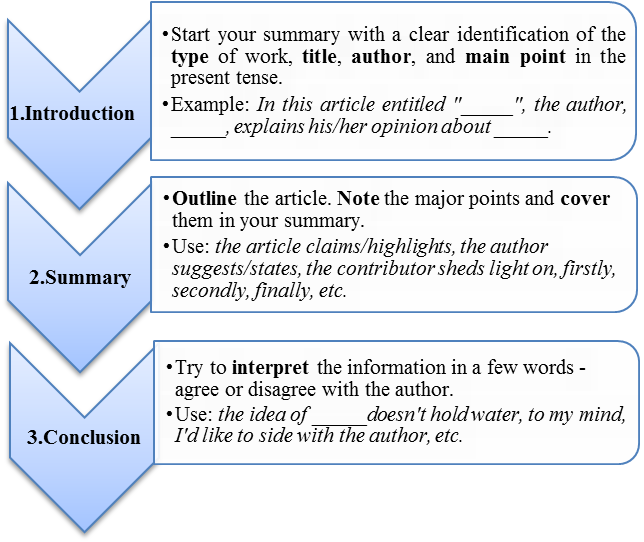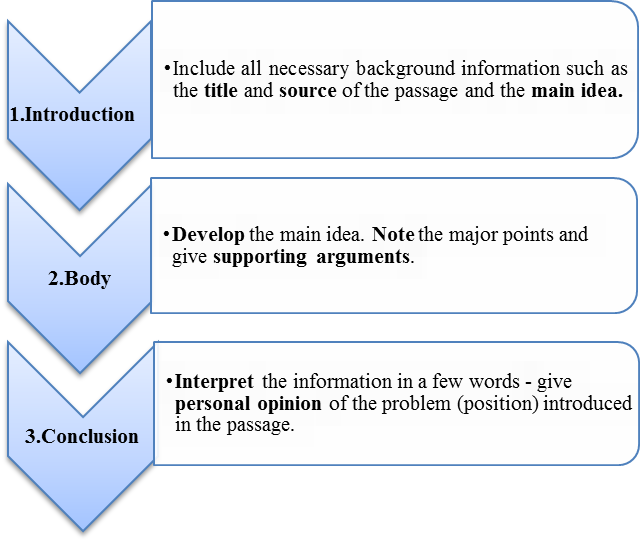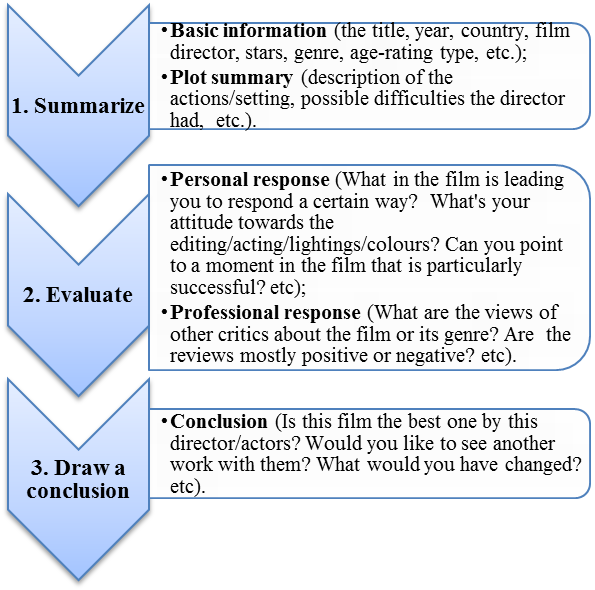Compare and contrast the two performances, share your impression of each of them.
12. Practice reciting the monologue.
Writing
Choose a play you have recently seen and write a review of your own.
14. Study the repertory of Yekaterinburg’s theatres. Write 3 recommendations to make British tourists visiting the city get interested.
APPENDIX 1
HOW TO MAKE A SUMMARY
 A summary is produced to show a teacher that you have read and understood the text. Surely, it has a certain structure:
A summary is produced to show a teacher that you have read and understood the text. Surely, it has a certain structure:
FOLLOW THE TIPS
1) Use your own wording, not the sentences from the article;
2) Refer to all the main ideas;
3) Use “summarizing language”. Periodically remind your reader/listener that this is a summary by using phrases mentioned above.
(http://public.wsu.edu/~mejia/Summary.htm)
APPENDIX 2
HOW TO RENDER AN ARTICLE
A rendering is a text based on the notional compression of the original with the aim of rendering its general matter.

FOLLOW THE BASIC PRINCIPALS
1) decide on what should be expressed and what should be suppressed;
2) express facts as plain statements with reference to the author of the article;
3) avoid evaluative words, phrases and statements in the body;
4) avoid figurative language;
5) use link words and introductory formulas to make your rendering sound
FOLLOW THE STRATEGIES
1) read the text and grasp the main idea and identify the topic;
2) read the text again and divide it into logical parts;
4)single out the main idea of each part;
5)give a summary of each part;
look for minor peculiarities of the article;
identify the author’s opinion;
state the questions which remained unanswered in the article;
speak on the conclusion the author comes to;
point out the facts that turned out to be new for you;
state what places of the article contradict your former views;
express your own point of view on the problem discussed;
if it is possible add your tail to the questions which remained unanswered in the article.
The introductory formulaslisted below can be of use:
1. The headline of the article is ... The article is headlined ... The headline of the article I’ve read is...
2. The author of the article is...
3. The article is taken from the...
4. The central idea of the article is about... The main idea of the article is... The article is devoted to... The article deals with... The article touches upon... The purpose of the article is to give the reader some information on... The aim of the article is to provide a reader with some material on...
5. The paper (article) discusses some problems relating to (deals with some aspects of, considers the problem of, presents the basic theory)... The paper (article) is concerned with (devoted to)…
6. The paper (article) begins with a short discussion on (deals firstly with the problem of)... The first paragraph deals with...
7. First (at first, at the beginning) the author points out that (notes that, describes)...
8. Then follows a discussion on... Then the author goes on to the problem of...The next (following) paragraph deals with (presents, discusses, describes)... After discussing... the author turns to... Next (further, then) the author tries to (indicates that, explains that)...It must be emphasized that (should be noted that, is evident that, is clear that, is interesting to note that)...
9. The final paragraph states (describes, ends with)... The conclusion is that the problem is... The author concludes that (summarizes the)... To sum up (to summarize, to conclude) the author emphasizes (points out, admits that...) Finally (In the end) the author admits (emphasizes) that...
10. In my opinion (To my mind, I think)... The paper (article) is interesting (not interesting), of great importance (of no importance), valuable (invaluable), up-to-date (out-of-date), useful (useless)...
It would be a good idea to link ideas by means of discursive words and phrases: first, firstly, first of all, to start with, to begin with, secondly, thirdly, moreover, in addition, finally, lastly, not only…but also, on the one hand, on the other hand, as a result, for this reason, therefore, thus, because of this, in consequence however, nevertheless, in spite of, despite this, even though, for example, for instance,such as, in my opinion, to my mind, as I see it, I believe (that), some people believe that, according to, it is said (that), to conclude, in summary, to sum up, in conclusion, to conclude.
APPENDIX 3
HOW TO WRITE A REVIEW
A formal analysis of a film requires that the viewer breaks the film down into its component parts and discusses how those parts contribute to the whole. These parts are as follows:

WRITING TIPS
1) Create an umbrella argument– some larger argument under which several observations and perspectives might stand;
2) Don’t simply summarize the film, keep in mind the use of camera angles or editing techniques;
3) Don’t limit yourself to a discussion of plot and characters;
4) Avoid the “I” but try to find a more objective way of beginning your sentences instead of sounding biased.
(http://dartmouth.edu/writing-speech/)
APPENDIX 4
PROGRESS TESTS “CINEMA”
